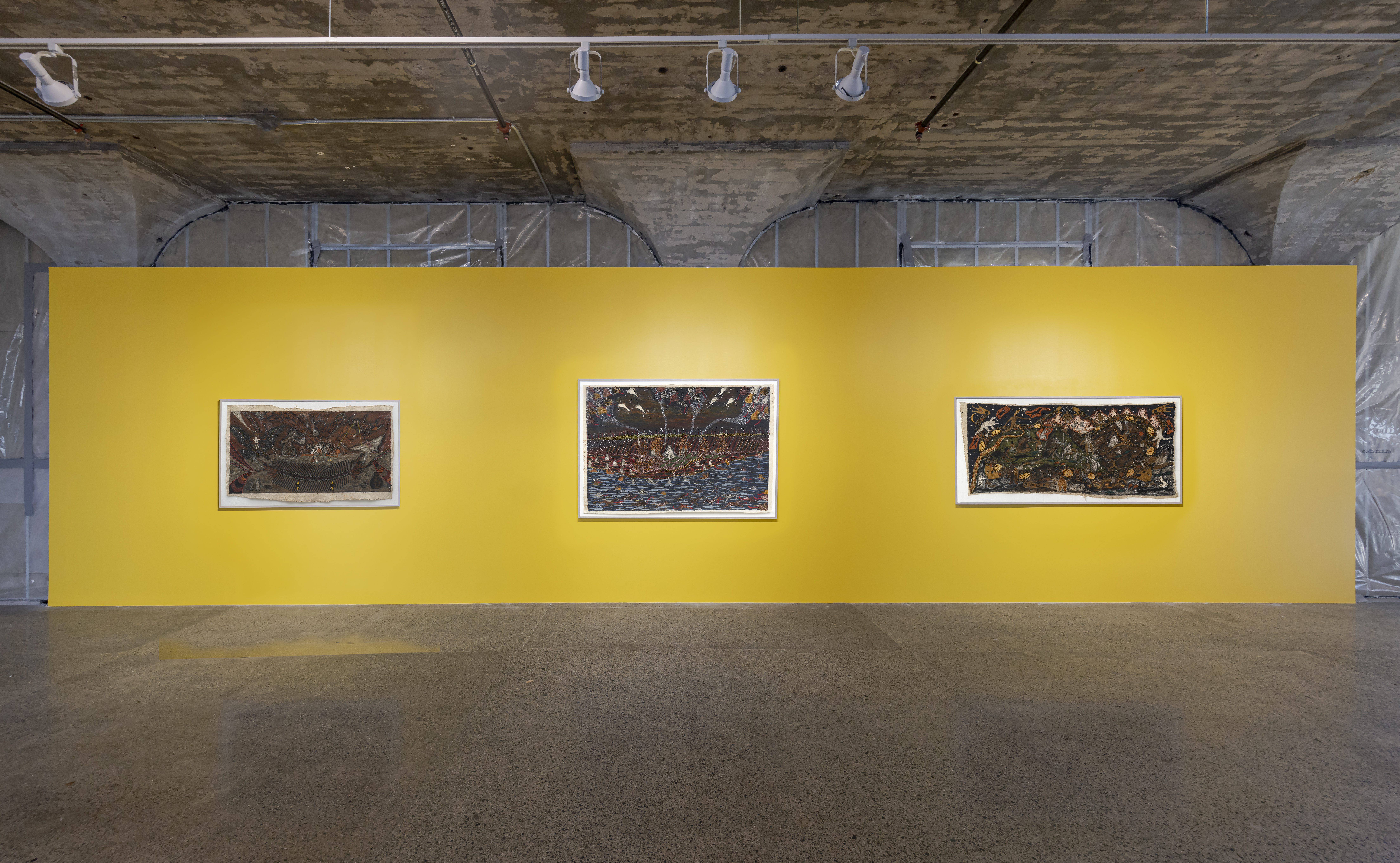September 21 – December 1
Examen de bancos en la cueva del saber (Examination by the pipe-smoking shamans at the knowledge cave) (2021) and Sesión de tabaco (Tobacco smoking session) (2022) underscore the profound spiritual and cultural significance of tobacco plant medicine in the Amazonian culture. Amazonian curanderos (shamans) use tobacco as a sacred tool to open up to others and establish communication with spirits. This perspective challenges the Western instrumentalized vision of ingestion, presenting tobacco as a living being with knowledge and strength that are in conversation with human energy.
Curación con ajo sacha a Shanticito (Shanticito being healed with wild garlic) (2020) was created as part of a series of paintings documenting his personal experience of having Covid-19 and the responses of the local Amazonian Indigenous communities to the pandemic. His illness influenced his paintings, which took on gloomy tones and introspective representations, including many self-portraits where master plants and Indigenous science heal him.
Santiago Yahuarcan’s paintings are a testament to the consciousness, affection, and intelligence of the rainforest and its inhabitants. Through the overlapping of bright-coloured figures in dense groupings that combine symbolic or descriptive references to colonial violence and spiritual worlds, they encapsulate the memories of Yahuarcani’s ancestors, the sacred knowledge of medicinal plants, the voices of the elders, and Amazonian stories of life’s origins, all in a manner that demands attention and respect.
Made possible with the generous support of Michael Krichman and Carmen Cuenca.
Bio
Santiago Yahuarcani (b. 1960) is a self-taught artist, and indigenous leader of the Uitoto people. His mother, Martha López, was a descendant of Gregorio López, the only member of the Aimeni clan (the white heron clan) who migrated from La Chorrera, now part of the Colombian Amazon, to the Ampiyacu River region, now northern Peru’s Amazon, as part of the relocation of enslaved indigenous populations to work in the rubber industry. Thus, her work addresses issues of documentation of indigenous knowledge, Amazonian ontologies, and the politics of genocide against their ancestors.
The artist has participated in the 60th Venice Art Biennale ‘Stranieri Ovunque – Foreigners Everywhere’, as well as the Toronto Biennial of Art, the Mercosur Biennale and was part of the Gwangju Biennale in 2023. His works are part of the collection of the Tate Gallery, Museo Reina Sofía, MASP, Kadist, Van Abbemuseum, Museo de Arte de Lima, among others.
Location
- Accessibility
The Auto BLDG, 9th Floor
- Accessible entrance
- Accessible washrooms
- Elevator
- AODA-compliant building
If you require automatic doors to access our exhibition space, please enter through the back entrance of 158 Sterling Road and take the elevators located in the southwest vestibule to the 9th floor.
If you require assistance entering the Toronto Biennial on Tuesdays between 10am – 6pm or Wednesdays-Sundays between 10am – 11am, please call 416-530-7474 or enter through the back of the building.
Parking: Located at 152 Sterling Road in the Hines Parking Garage, just west of the museum. This is an underground parking lot. Hourly and daily rates apply.
Note: When exiting the parking lot, please use stairwell D for the most convenient access to the Auto BLDG.
- Getting There
The Auto BLDG, 9th Floor
By subway: The Auto BLDG is a 10-minute walk from both Lansdowne Station and Dundas West Station.
By streetcar: The Auto BLDG is a 5-minute walk from the closest streetcar stop at Dundas St West and Sterling Rd. This can be reached by the 505 Dundas and 506 Carlton streetcars.
UP Express: The Auto BLDG is a 10-minute walk from Bloor Station, which is two stops on the UP Express from Toronto Pearson Airport and one stop from Union Station.

